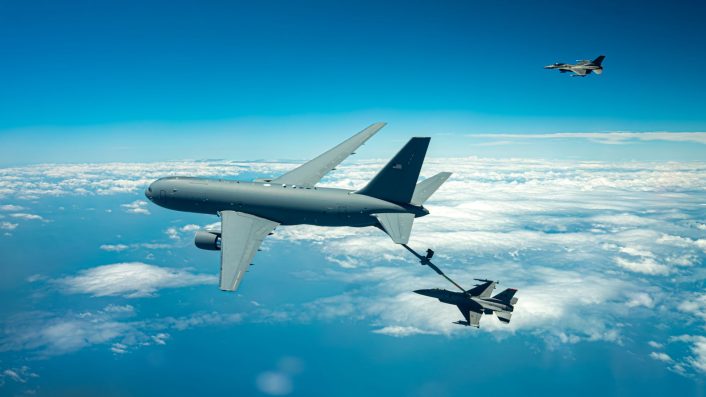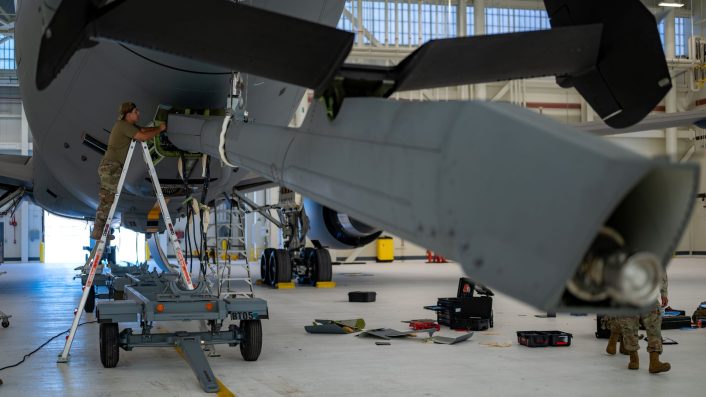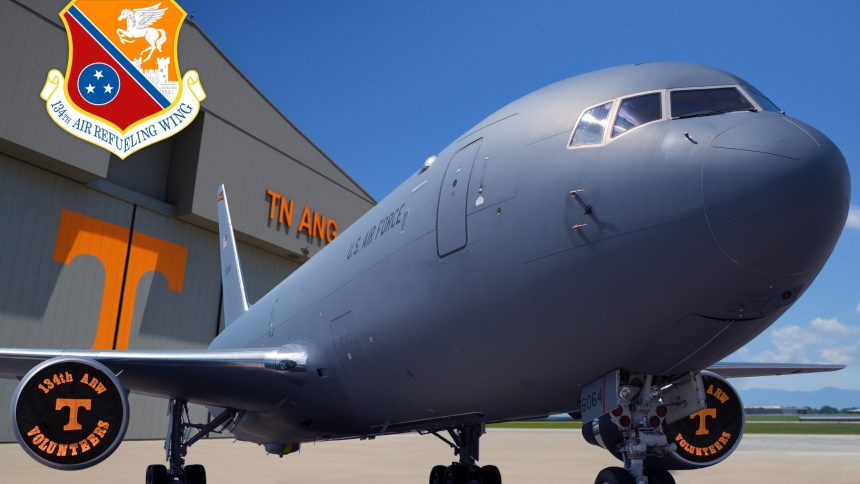Boeing is now testing the new Remote Vision System 2.0 for the KC-46A’s troubled telescoping boom system, which addresses serious Category 1 deficiencies.
The Department of the Air Force announced on Nov. 19, 2025 that McGhee Tyson ANGB (Air National Guard Base), Tennessee, has been selected as the preferred location for the Main Operating Base (MOB) 7 of the KC-46A Pegasus fleet. The 134th Air Refueling Wing based there will receive eight new tankers, with the first delivery in 2031 following a final basing decision expected in 2027.
The development comes as manufacturer Boeing works towards resolving a host of technical issues on the Pegasus. The leading snag is the Remote Vision System (RVS) of the refueling boom, with visibility and depth perception handling issues, and a host of other Category 1 deficiencies with the overall airframe.
Boeing Defense chief Steven Parker recently said, on the sidelines of the Dubai Air Show, that the company has begun flight tests with an improved RVS 2.0 at its Seattle facility. Breaking Defense reported that Boeing has been delivering Pegasus refuelers with what the Air Force dubs RVS 1.5, a marginally improved system over the RVS 1.0 version.
Pumped for a flyaway Friday. ✈️⛽️
Today’s #KC46 delivery marks the 18th Pegasus tanker for @Travis60AMW. With fuel, cargo and data for the mission, the KC-46A provides more capability and capacity to service members around the globe. pic.twitter.com/5Ii8NdNFiB
— Boeing Defense (@BoeingDefense) November 14, 2025
KC-46A Pegasus tankers at McGhee Tyson ANGB
According to the press releases by the 134th ARW and the National Guard, should the final decision confirm the location, McGhee Tyson ANGB will receive its first KC-46 in 2031 and start replacing all its KC-135 Stratotankers. The final basing decision, however, is conditional on an environmental impact analysis which is expected by 2027.
The Air Force already named in September 2024 McGhee Tyson ANGB among the seven ANG candidate locations for potential basing of the KC-46.If McGhee Tyson ANGB is ultimately chosen, the 134th ARW would become the third ANG unit to operate the KC-46A, after the 157th ARW at Pease ANGB, New Hampshire, and the 117th ARW at Sumpter Smith Joint National Guard Base, Alabama.
The 134th ARW has also constructed a new $134 million 10,000-foot runway and a $32.4 million maintenance hangar for the KC-46 aircraft, according to the National Guard release.
US Air Force KC-135 Stratotankers preform an elephant walk and minimum interval takeoffs during 134th Air Refueling Wing’s operational readiness exercise at McGhee Tyson Air National Guard Base, Tennessee, April 2. pic.twitter.com/Pk35X5ZYis
— Ryan Chan 陳家翹 (@ryankakiuchan) April 4, 2023
There are well over 81 KC-46A Pegasus tankers in service with the U.S. Air Force, after Boeing reported that figure on Feb. 8, 2024 following the delivery of the 19th KC-46 to Joint Base McGuire-Dix-Lakehurst. On Oct. 4 and Nov. 15, 2025, Boeing reported the delivery of the 17th and 18th Pegasus tankers to Travis AFB, California.
Remote Vision System issues
The RVS 2.0 has been delayed, slipping from an original delivery timeline of 2023, and is now finally expected in 2027. A leading issue with the RVS is its camera-enabled visual handling configuration, replacing a system on legacy tankers where boom operators peer out a window to guide telescopic refueling rods to receptacles on aircraft.
The remotely operated telescoping boom and camera-enabled system struggles with dynamic lighting, complicating nighttime refuelings, while daytime refueling can be “washed out by sunlight,” Breaking Defense reported.
NEWS: 418th FLTS at Edwards executes historic trilateral test with @AusAirForce @RoyalAirForce. #RAAF E-7A now compatible with @usairforce KC-46, future test teams gain early knowledge ahead of anticipated E-7 fielding.
More- https://t.co/qvtPRzHxK3@HQ_AFMC @AFLCMCofficial pic.twitter.com/sMasEilJdB
— Edwards Air Force Base (@EdwardsAFB) April 28, 2025
Depth perception issues with the camera feed on the screen may cause a boom operator to possibly strike an aircraft, and these issues have thus been classified as Category 1 deficiencies. RVS 2.0 has two new long-wave infrared and two visible spectrum cameras, along with a pair of visible spectrum cameras, for a total of six lenses.
“We had the first flight with the new remote visual system. So that’s a huge milestone for the programme,” Parker told reporters, according to Aerospace Global News. Boeing agreed to the Air Force’s demand in April 2020 to redesign the entire RVS and introduce the RVS 2.0 at no additional cost to the government.
However, a series of technical, critical design reviews and certification for commercial off-the-shelf camera hardware kept pushing the RVS 2.0 delivery beyond 2026. A service-wide retrofit is now expected in 2027, when RVS 2.0 is certified and approved for delivery.

AGN further quoted Parker who acknowledged the issues and delays with the RVS: “And so we’ll go into testing now in 2026 and do contact testing eventually here as well.” Boeing executives also reiterated in Dubai that the interim RVS 1.5 is performing “exceptionally.”
Other KC-46A Pegasus problems
The KC-46A Pegasus program has been beset by a series of technical and design issues, some of which too are classified as “Category 1.” These deficiencies are those that endanger both the aircraft and the crew.

March 2025 saw the USAF pausing additional deliveries of the tanker and a fleet-wide inspection of its 89 aircraft after cracks were discovered in the outboard fixed-trailing-edge support structure of two planes. These aircraft were set to be handed over to the service from the factory when the issue was discovered.
Another problem, specifically with an actuator inside the boom, prevents the A-10C to be refueled. In fact, the A-10 can’t generate enough force to stay connected to the boom due to its low speed, so the hydraulic actuator provides that force to keep the boom rod in the receptacle. A new actuator is expected by 2026 to solve the problem.
Improperly placed couplings in the fuel lines and an issue with the AAR receptacle on top of the cockpit also risked fuel leaks inside the aircraft and the cockpit.










